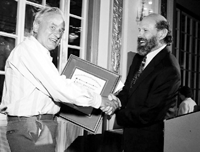Von Neumann Lecture 2003: New Insight into Two-Phase Flow Models
September 30, 2003

SIAM president Mac Hyman (right) congratulated 2003 John von Neumann lecturer Heinz-Otto Kreiss, who was honored for "his pioneering research in the accuracy and stability of numerical approximations of time-dependent partial differential equations." That research, according to the prize committee, has had a profound impact on "our understanding of hyperbolic equations, turbulence and other multiscale systems."
In numerical simulations, dissipation is typically added to stabilize the numerical scheme. This, of course, has the effect of making the system parabolic, and hence at least locally well-posed. In fact, some dissipation occurs in every physical system, and this computational procedure is thus a reasonable approach when exact models of viscosity and other dissipative forces are not known. The models themselves, and this procedure for dealing with them computationally, however, remain a center of controversy.
Enter Kreiss. The work he discussed in the lecture, and in the recent paper with J. Ystr�m on which the lecture was based,* is an analytical and computational study of several model parabolic systems that share the property of having complex characteristics in the limit. This work articulates and illustrates an important conclusion: Ill-posed problems of this type cannot be stabilized by the addition of viscosity. Kreiss and Ystr�m have proved that the conclusions that can be drawn from linear, constant-coefficient prototypes, where Fourier analysis predicts exponential growth proportional to the ratio of the imaginary part of the characteristics to the viscosity, remain valid for a wide class of model systems.
On the other hand, fascinating behavior has been observed in some systems for which some sort of energy or entropy inequality---not necessarily a strong one---obtains. Now the solutions do not grow unboundedly in amplitude; instead, they oscillate. In the case of nonlinear equations, shocks arise, consuming energy and apparently stabilizing the system. Roughly, the balance is that energy grows like the square of the amplitude, due to the imaginary part of the characteristics, but decays like the cube (in inverse proportion to the viscosity in both cases). We are all used to the principle that "entropy increase is proportional to the cube of the shock strength" for small shocks; this principle, when it also holds for large amplitudes, actually prevents the growth of oscillations. Thus, the instabilities presented by nonlinear systems may be quite different from those predicted on the basis of linear theory.
The fact that a nonlinear system might not display a Hadamard instability, Kreiss was careful to warn, does not mean that it is possible to take the zero-viscosity limit; nevertheless, this is one of the first solid pieces of nonlinear analysis with the capability of describing what is really taking place in this limit. It offers a firm basis on which future engineering discussions can proceed much more fruitfully.
---Barbara Keyfitz, Department of Mathematics, University of Houston.
*H.-O. Kreiss and J. Ystr�m, Parabolic problems which are ill-posed in the zero dissipation limit, Math. Comput. Modelling, 35 (2002), 1271-1295.

